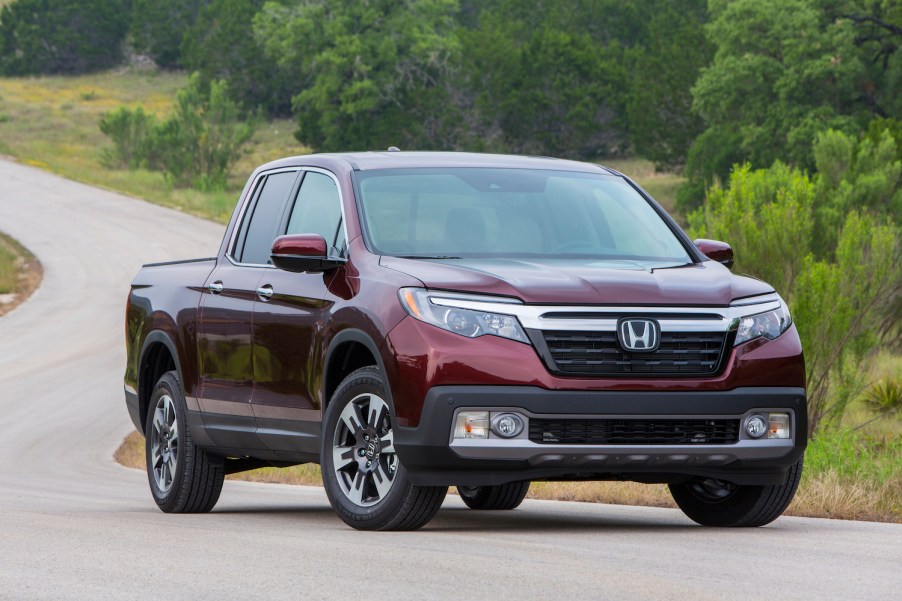
The Honda Ridgeline Myth: Even Heavier Than the Toyota Tacoma
Most motorheads know the difference between full-frame and unibody trucks. And whichever they prefer, they’ll say that a unibody vehicle is lighter and more efficient. But in the case of the Honda Ridgeline, this is just not true. The Ridgeline actually weighs more than some Toyota Tacomas and gets very similar fuel mileage. Here are the details:
| Honda Ridgeline | Toyota Tacoma | |
| Weight | 4,436-4,475 pounds | 3,915-4,550 pounds |
| V6 Fuel Mileage | 18 city/24 highway MPG | 19 city/24 highway MPG |
| Horsepower | 280 hp | 278 hp |
| Torque | 262 lb-ft | 265 lb-ft |
| 0-60 (MotorTrend) | 6.3 seconds | 7.0 seconds |
| Max towing capacity | 5,000 pounds | 6,400 pounds |
What is the difference between a full-frame and a unibody truck?
Automakers attach a full-frame truck’s axles and powertrain to a “ladder frame” before installing a pickup body on top. Thus the name: body-on-frame. A unibody vehicle features a reinforced body shell instead of a separate frame.

For example, the Toyota Tacoma is a full-frame pickup truck. During the assembly process, Toyota first builds a rolling chassis complete with engine, transmission, and axles. You could, conceivably, drive it around like this. Then Toyota installs a Tacoma or 4Runner body atop this frame.
The Honda Ridgeline, on the other hand, is a unibody pickup truck. Its reinforced body shares its design with the Pilot crossover SUV. Honda begins Ridgeline assembly with a body. Then it installs the transverse-mounted V6, FWD or AWD, and independent suspension at all four corners.
Is full-frame or unibody construction better?
Once upon a time, every vehicle used body-on-frame construction. By the 1960s, most automakers discovered that a unibody vehicle was lighter, nimbler, more efficient, and could be lower to the ground. While cars are all unibody, most pickup trucks retain full-frame construction for added strength.

A full-frame vehicle is often better off-road or while pulling a heavy trailer. This is because a full-frame vehicle is much less likely to flex under load or while navigating extremely hilly terrain. Full-frame vehicles are also easier to modify, and sometimes last longer.
Most automotive enthusiasts believe that a unibody vehicle will be much lighter–because its not lugging around a heavy ladder frame. This weight savings is supposed to improve acceleration, stopping time, handling, and even fuel efficiency. For this reason, crossover sales have overtaken full-frame SUV sales. But the truth is rarely so simple. The Honda Ridgeline, for example, can weigh more than the full-frame Toyota Tacoma.
How do the Honda Ridgeline and Toyota Tacoma stack up?
The Honda Ridgeline and Toyota Tacoma make nearly identical power numbers and similar weights. The Ridgeline’s low stance and independent suspension imbue it with a much smoother ride and responsive handling. Its acceleration isn’t quick, but it gets along much faster than the sluggish Tacoma.

The Tacoma’s full ladder-frame and solid rear axle make it a much better vehicle for towing. While the Honda Ridgeline has a maximum tow rating of 5,000 pounds, you can configure a Tacoma to pull up to 6,400 pounds. The Tacoma’s solid axle should also make it feel much more stable when pulling a heavy load.
Finally, while you can get a Honda Ridgeline with AWD, you’ll struggle to install a lift kit or take it rock crawling on a difficult off-road trail. The Tacoma’s design makes it an excellent choice for complex off-roading, including obstacles that lift an entire wheel off the ground.
Because you can get a range of cab and bed configurations of Tacoma, its weight ranges from just 3,915 to 4,550 pounds. The Ridgeline, on the other hand, only comes with four doors and a single bed size. As a result, every new Ridgeline weighs in at 4,400 pounds and change.
The Toyota Tacoma are very different tools, and both excel at very different jobs. But their difference is not as simple as weight or power output.
Next, read about why the Honda Ridgeline is Consumer Reports’ favorite truck or see how these two trucks stack up in the head-to-head review in the video below:



